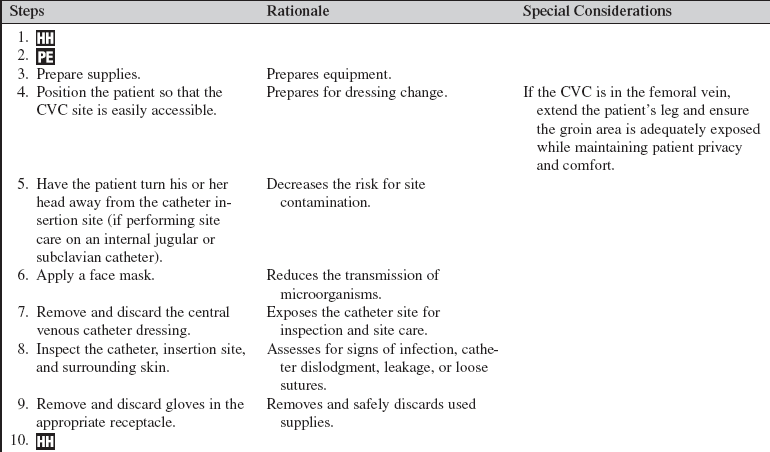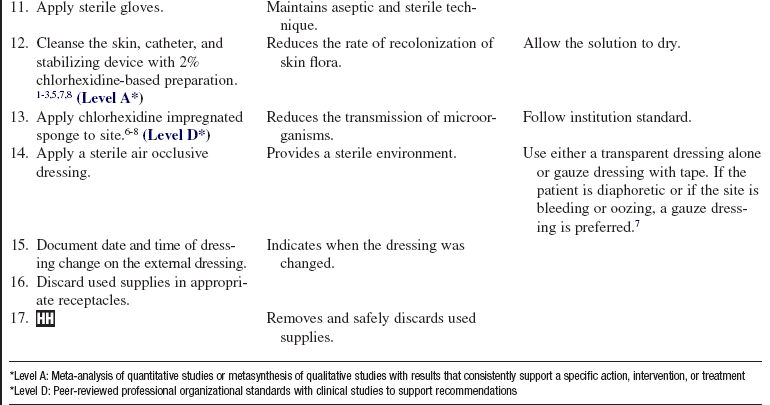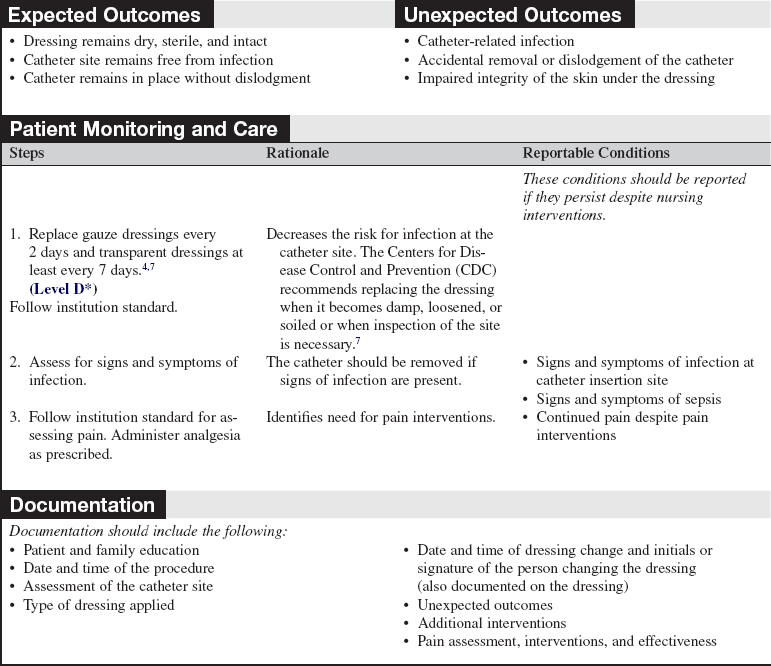Central Venous Catheter Site Care
PREREQUISITE NURSING KNOWLEDGE
• Understanding of the principles of aseptic technique is needed.
• Knowledge of the signs and symptoms of catheter-related infection and sepsis is necessary.
• Most serious catheter-related infections are associated with central venous catheters (CVCs), especially those that are placed in the intensive care setting.7
• Bloodstream infections related to the use of CVCs are an important cause of patient morbidity, mortality, and increased healthcare costs.2
• Topical antibiotic ointment or creams are not recommended on the catheter insertion site. The use of antibiotic ointment or cream can potentially promote fungal infections and antimicrobial resistance.7,8
EQUIPMENT
PATIENT ASSESSMENT AND PREPARATION
Patient Assessment
• Assess the patient’s arm, shoulder, neck, and chest on the same side as the catheter insertion site for signs of pain, swelling, or tenderness. Assess the patient’s leg size and assess for signs of pain, swelling, or tenderness on the same side as the catheter insertion site if the CVC is placed in the femoral vein.  Rationale: Assessment evaluates for thrombophlebitis or venous thrombosis.
Rationale: Assessment evaluates for thrombophlebitis or venous thrombosis.
• Assess for signs and symptoms of infection. Signs and symptoms may include redness, swelling, and drainage at the catheter site or fever, chills, and positive blood cultures.  Rationale: Infection is a potential complication of any invasive catheter.
Rationale: Infection is a potential complication of any invasive catheter.
• Assess the patient’s history for sensitivity to antiseptic solutions.  Rationale: Assessment decreases risk for allergic reactions.
Rationale: Assessment decreases risk for allergic reactions.
Patient Preparation
• Verify correct patient with two identifiers.  Rationale: Prior to performing a procedure, the nurse should ensure the correct identification of the patient for the intended intervention.
Rationale: Prior to performing a procedure, the nurse should ensure the correct identification of the patient for the intended intervention.
• Ensure that the patient and family understand preprocedural teaching. Answer questions as they arise, and reinforce information as needed.  Rationale: Understanding of previously taught information is evaluated and reinforced.
Rationale: Understanding of previously taught information is evaluated and reinforced.
• If the patient is on ventilatory support, assess the patient’s need for suctioning before beginning the procedure. Femoral catheter sites need to be inspected for potential contamination with urine or stool.  Rationale: The risk for catheter site contamination by secretions or excretions is minimized.
Rationale: The risk for catheter site contamination by secretions or excretions is minimized.
References
1. Balamongkhon, B, Thamlikitkul, V. Implementation of chlorhexidine gluconate for central venous catheter site care at Siriraj Hospital, BangkokThailand. Am J Infect Control. 2007; 35:585–588.
![]() 2. Chaiyakunapruk, N, Veenstra, DL, Lipsky, BA, et al, Chlorhexidine compared with povidone-iodine solution for vascular catheter-site care. a meta-analysis. Ann Intern Med 2002; 136:792–807.
2. Chaiyakunapruk, N, Veenstra, DL, Lipsky, BA, et al, Chlorhexidine compared with povidone-iodine solution for vascular catheter-site care. a meta-analysis. Ann Intern Med 2002; 136:792–807.
![]() 3. Eggimann, P, Harbarth, S, Constantin, M. Impact of a prevention strategy targeted at vascular-access care on incidence of infections acquired in intensive care. Lancet. 2000; 355:1864–1868.
3. Eggimann, P, Harbarth, S, Constantin, M. Impact of a prevention strategy targeted at vascular-access care on incidence of infections acquired in intensive care. Lancet. 2000; 355:1864–1868.
4. Infusion Nurses Society. Infusion nursing standards of practice. J Infus Nurs. 2006; 29:S1–S92.
5. Maenthaisong, R, Chaiyakunapruk, N, Visanu, T. Cost–effective analysis of chlorhexidine gluconate compared with povidone-iodine solution for catheter-site care in Siriraj -HospitalThailand. J Med Assoc Thai. 2006; 89:S94–S101.
![]() 6. Maki, DG, Narans, LL, Knasinski, V, et al. Prospective, randomized, investigator-masked trial of novel chlohexidine-impregnated disk (Biopatch) on central venous and arterial catheters [abstract]. Infect Control Hosp Epidemiol. 2000; 21:96.
6. Maki, DG, Narans, LL, Knasinski, V, et al. Prospective, randomized, investigator-masked trial of novel chlohexidine-impregnated disk (Biopatch) on central venous and arterial catheters [abstract]. Infect Control Hosp Epidemiol. 2000; 21:96.
![]() 7. O’Grady, NP, et al. Guidelines for the prevention of intravascular catheter-related infections. Am J Infect Control. 2002; 30:89–476.
7. O’Grady, NP, et al. Guidelines for the prevention of intravascular catheter-related infections. Am J Infect Control. 2002; 30:89–476.
![]() 8. Safdar, N, Klugar, DM, Maki, DG, A review of risk factors for catheter-related bloodstream infection caused by percutaneously inserted, noncuffed central venous catheters. implications for preventive strategies. Medicine 2002; 81:466–472.
8. Safdar, N, Klugar, DM, Maki, DG, A review of risk factors for catheter-related bloodstream infection caused by percutaneously inserted, noncuffed central venous catheters. implications for preventive strategies. Medicine 2002; 81:466–472.
Alexander, M, Corrigan, A, Gorski, L. Infusion Nurses -Society Infusion NursingAn Evidence-Based Approach, ed 3. Saunders; 2010.
Gillies, D, et al. Gauze and tape and transparent polyurethane dressings for central venous catheters, Cochrane Database Sys Rev. Chichester, UK: John Wiley & Sons, Ltd; 2003.
Maki, DG, Kluger, DM, Crnich, CJ, The risk of bloodstream infection in adults with different intravascular devices. a system review of 200 published prospective studies. May Clin Proc 2006; 81:1159–1171.

 Rationale: Explanation prepares the patient and decreases patient anxiety.
Rationale: Explanation prepares the patient and decreases patient anxiety. Rationale: Patient cooperation is increased; the potential for contamination is decreased.
Rationale: Patient cooperation is increased; the potential for contamination is decreased.


